#hard to remain invested in a franchise when efforts to hold out hope OR let go and accept canon as it is could be undermined at any time
Text
Just saw Joker described as a '2nd year' in the P5 Tactica information, which is gaaaaaaaaaaaaaah--
I swear, for a series with a message of moving forward, Persona (see: Atlus) sure loves to avoid moving forward. Never mind complaints about more P5 content -- I'm here for side games and returning character storylines -- they are keeping the Phantom Thieves stuck in a Peter Pan state.
Where is that willingness to move forward that came with the P4 Arena games? For the P3 and P4 kids? Man, just the P4G epilogue alone took us as far as Strikers did timeline-wise.
And speaking of Strikers, the sole actual sequel to P5? Evading or hiding half of the characters we'd be love to revisit, and generally dodging Royal's entire existence? Woof.
#don't mind me just salty that atlus keeps revisiting P5 YET REFUSES to close open threads or even acknowledge whole ass main characters#and just keeps doing these 'it might as well be a dream' games that feel like narrative bottle episodes#might I be completely off base and Tactica WILL add something new to the big picture? maybe. I'd love to be wrong.#I'm just getting worn out after half a decade of a slow burn tease that just keeps adding reasons to hold on with little to no payoff#hard to remain invested in a franchise when efforts to hold out hope OR let go and accept canon as it is could be undermined at any time#a lot akechi related BUT kasumi and the other thieves' royal-specific ambitions also apply. And all of the confidants I'd love to see again#What's going to happen to Morgana long term? Where will Ann end up? How will Ryuji's school transfer go?#What amazing new art might Yusuke make? What government is Futaba going to-- I mean uh what awesome career is she going to pursue?#What will Shinya look like a year out? Can I see Hifumi make a comeback? How's Mishima doing? Chihaya?#Can I see a Kawakami and Takumi NOT riddled with stress for a heartbeat? Some exploration of Jose???#And the PERSONA 4 CREW! I have been waiting for them to get their 'P3 in Arena' treatment for forever and I am TIRED OF WAITING ATLUS#persona 5 tactica spoliers#maybe delete later#depends how salty this looks to me in a better mood
10 notes
·
View notes
Text
Fear Won't Last (Modern Agni x Reader)
[B]This was a one shot I originally posted on my Wattpad account for another franchise, but I thought it would better suit our lovely khansama. Enjoy~
~~~~~~~~~~~~~~~~~~~~~
Social Anxiety Disorder • SAD • Social Phobia •
--------------------------------------------------
Meaning:
A chronic mental health condition in which social interaction causes irrational anxiety.
------------------------------------------------
The first encounter had been a mere accident.
Cersei Lannister's permanent conniving smirk remained frozen on the television screen whilst you lolloped about in the kitchenette, preparing a hot drink and something sweet to sink your teeth into.
The thunderstorm that had been impertinent enough to negate yesterday's promising forecast had finally begun to settle down, now leaving only the comforting pattering of raindrops against the windows in its place. Not that you minded the more miserable side of the weather – it was actually the perfect atmosphere for a relaxing day at home crammed with television and fatty foods.
During the short journey back to the couch, you can't help but steal an innocently curious glance outside the window, or more specifically, into the apartment directly across the street. You hadn't meant to be a nosey Nellie, but it was a lovely apartment – so much nicer than your own. Expensive furniture, immaculate, exquisite artwork...truly an interior worthy of admiration.
A flash of exotic olive skin captured your attention.
And that's when you saw him.
The man with the silver eyes.
He must have only moved in recently for you were fairly certain that apartment previously belonged to a middle-aged fellow morally opposed to showering.
But this man...
As though sensing someone gawking, the man abruptly paused mid push up and angled his head towards the window. He caught your eye and held your unwavering stare.
Now a normal person would have hastily turned away by now after getting caught, but you were unable to move. Fear kept you firmly rooted to the floorboards, unwilling to relinquish its possessive grasp. Those piercing orbs of gleaming silver tore open your chest and invaded your soul; even though being wrapped up in a pair of fluffy pyjamas, you had never felt so naked and exposed.
Then he smiled, and the chains that bound you were broken.
With a frightened squeak, you rushed towards the window and yanked the curtains shut, keeping you safe from the world's prying eyes.
At least for the time being.
********************
The second encounter occurred a few days later.
Wrapped in nothing but a towel and free of burdens, you danced jovially around the lounge, belting out lyrics in time with the Hamilton soundtrack currently blaring in the background – for those twenty minutes, you were Alexander Hamilton.
You prance across the rug, gaining momentum, and leap onto the couch cushions. You dip and sway, bounce and wiggle, all for an imaginary audience.
Or so you thought...
Turns out there sat one highly invested onlooker across the street; sultry lips had curled upwards into an amused smile when first catching sight of you attempting to perform a pirouette, only to lose your balance and flop haphazardly onto the couch with a giggle. His smile morphed into a grin when you finally looked over, (colour) eyes blinking owlishly.
How long had he been watching?!
Nearly choking on your own humiliation, you scramble off the couch and fumble towards the window with the intent of closing the curtains. But once touching the heavy fabric, you find yourself pausing, and instead redirect your undivided attention to the silver-eyed stranger.
Why was he smiling? Rarely anyone even glanced in your direction, let alone smile – and without a single trace of mockery!
The man raised a hand and waved.
You would have reciprocated had you not been more inclined to admire the defined, deliciously toned muscles decorating his shoulder and arm. When he lowered his arm, those muscles moved and rippled under satin looking skin.
You find your gaze automatically drawn to him despite the fear currently worming its way into your heart. There was something hypnotic about this individual. Something that went beyond the perfectly sculpted torso he so proudly left on display for all the neighbours to ogle. He must have been working out again if those flushed cheeks and glistening bare chest were anything to go by. You try not to come off as a pervert by allowing your eyes to freely roam his body, but it was difficult to ignore the tantalising sight of a V-line peaking out over the dipping waistband of black sweatpants.
After a highly thorough visual examination, your eyes finally settle on his face, just in time to catch his eyes finishing their own perusal.
And then you shut the curtains.
******************
The third meeting...
You had been confronted by rhythmic rap upon the front door one evening, which was extremely peculiar – for the past three years residing in the same apartment, not one person had come to visit, which is what your heart desired. To be quite honest, you doubted many people were actually aware of your existence.
The walls appeared to be closing in with each hesitant step taken towards the door, the air decreasing until only shallow sips of breath were attainable.
Silver eyes were the first thing to greet you.
His smile was warm and genuine; he had come to visit in hopes of striking up a conversation, apparently intent on getting to know you better. But your fear would not allow that. He was too close. Far too close. Your personal space was being invaded and you didn't much care for it.
A large male hand slammed against the wooden surface of the door when you went to slam it in his face, only serving to create additional stress for your person, but this exotic stranger failed to take notice of how distraught you were becoming. Instead he introduced himself – Agni was his name – and asked for an invitation inside – though that was an invitation which you hastily declined. More force was applied to the door on your end but it had little to no impact.
My, my, the man was persistent.
Most women would probably find such a trait to be endearing, but for you it was nothing short of an inconvenience.
It was obvious the look of distress upon your face went unnoticed as Agni continued speaking, hoping to obtain as much information from you as possible; what your name was, what you did for a living, if you were currently involved with someone, what your hobbies were, how you spend your evenings, if you'd like to grab a drink sometime?
But all you could do was choke out breathless strings of nonsensical stammers and incomprehensible syllables, feeling beads of perspiration poise delicately upon your hairline. The familiar sting of tears is the cue your bottom lip needed in order to begin quivering.
Crying before a stranger...how humiliating.
Agni seems taken aback by the reaction to his persistence and his hand slips from the door, granting you the opportunity to swiftly throw the door closed, locking it for good measure.
You have just enough time to shout an apology before hearing him disappear down the hallway.
****************
Agni raises his glass to the window with a smile warm enough to melt butter.
Your own glass is raised.
Were anyone to cast an inquisitive glance in your direction, they'd no doubt come to the conclusion that you had fallen victim to insanity. But they would be wrong. For if they looked hard enough, they would eventually see that, despite there being no one else in the apartment, you were in no way alone.
Agni presses an open notebook firmly against the window of his apartment. 'You look beautiful' is scrawled across the pages in letters large enough for you to read from your current position.
Interaction of this sort had been occurring on a daily basis for the past two weeks. You still couldn't understand why the man was so relentless in his pursuit of your affections, but the amount of effort he put into creating some type of relationship with you was incredibly flattering. No one had ever gone through so much trouble solely for you, so when he offered an invitation to dinner, you had to accept.
Of course, it wasn't what anyone would call a typical dinner; you'd much rather be by his side, feeling the soft, hot touch of his hand across a dinner table, losing yourself in the intoxicating scent of men's cologne, rather than being tucked away in your apartment having to fantasize. But you weren't ready to take such a humungous step, and somehow, Agni understood and accepted such a fact.
With your own notebook ready and waiting by your hand, you flip to a fresh page.
You're going to make me blush again.
You hold it up for him to read.
There was that gorgeous smile again.
If that happens, it means I'm doing a good job!
As if on cue, heat clawed its way onto your cheeks, leaving you to momentarily wonder if Agni could see the effect he had on you from where he sat.
You give a shake of your head.
So cocky!
I believe the word you're looking for is confident.
Hmm...no. No, cocky was definitely the right word. I could have been rude and used the word arrogant instead.
His hand shoots upwards and clutches at his chest.
You know where to strike so it hurts!
A soft laugh slips from your lips and you rest your elbows atop the table, taking a few seconds to admire him. There was a new beauty to his face every time you saw him. In the beginning it was mostly physical attributes, such as the unique colour of his eyes, or the perfectly sculpted physique which he allowed you to ogle as much as your heart desired. But lately, you could notice the things not everyone could; there was always a glimmer within his eyes whenever the pair of you conversed, or a smile which always threatened to split his face in half the moment your eyes connected, or the way he'd continuously steal glances into your apartment when he believed you weren't paying close enough attention. They were only little things, but they were what mattered most.
Agni wiggles his notebook against the glass to earn your attention.
You're staring.
You smile softly.
Is that a bad thing?
No. As long as you don't mind being stared at in return?
If you're the one doing the staring, then I don't mind.
He sets his notebook aside and places both hands against the glass, which compels you to do the same. It was crazy. You both were close enough to see one another's entire life, yet it felt as though there was so much more than a narrow street separating you – keeping you from being together.
Guilt had your hands falling from the glass and towards the notebook.
You needed to know.
Why are you doing this?
Even from here, it was easy to spot the confusion contorting such handsome features.
He picks up his own notebook.
Doing what?
Wasting time on a lost cause.
I don't understand.
Agni...surely you can't be happy with this arrangement? I'm not, and I'm the one that's keeping us divided! How can you be so willing to accept this situation?
Agni brings the marker to his lips and reads your words over and over again. You watch him with bated breath, fearing his response.
He begins to write, holding up his answer a minute later.
I know what it's like to be consumed by fear. Every day is a struggle. A battle no one else can see. But fear is never permanent. It goes away. And until that happens, I will be here, waiting to help you take the next step.
Something clicks inside of you after reading those words.
You find yourself writing a response before your brain even has a chance to comprehend it. You press it against the window.
I'm ready to take the next step...♡

#yana toboso#anime#one shot#reader x stories#so cute#reader insert#read more#reader#long reads#readromance#readreadread#reader x agni#anime / manga#madman#manga#fanfic#fangirl#mental ill health#mental illness awareness
7 notes
·
View notes
Text
Epic Movie (Re)Watch #159 - Star Trek (2009)

Spoilers Below
Have I seen it before: Yes
Did I like it then: Yes.
Do I remember it: Yes.
Did I see it in theaters: Yes.
Was it a movie I saw since August 22nd, 2009: No.
Format: Blu-ray
1) This was my first encounter with Star Trek. Ever. There may be a chance I saw The Motion Picture before this but I didn’t remember it. At all. This was it for me. And I have to say I’m grateful for that because it really pulled me into this world which I now thoroughly enjoy.
2) Our very first experience with this film are the soft notes of Michael Giacchino’s theme for the rebooted universe. I think Giacchino is the finest modern day composer around and I think Star Trek is his finest piece of franchise fare (while the score for Up might be his best work ever). Giacchino’s more fits like a glove with this world. It is new yet feels familiar, relating to the feelings of hope, adventure, and danger which is such a trademark of the series. Like all great scores, it helps hold up the film and I love it for that.
3) The attack on Kelvin is a gripping and excellent way to open the film. It features tense action and opens on a note of darkness and unexpectedness which will come to define the dangers of the film.
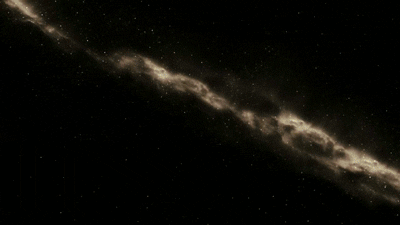
4)
Captain Robau: “You’re captain now, Mr. Kirk.”
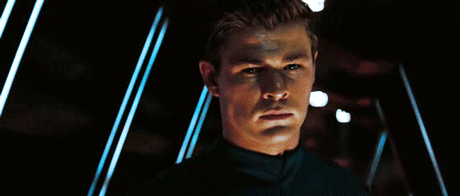
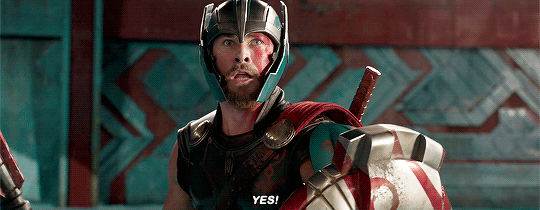
(GIF originally posted by @kamala-khan)
Chris Hemsworth features in a noteworthy pre-Thor role in this film. The referring to him as Mr. Kirk almost plays against expectations, because one might observe that he looks more like William Shatner in this film than Chris Pine does. In his short time in the film, Hemsworth’s George Kirk is able to do some incredible things. He is more a plot device than a character, establishing Kirk’s loss as well as the enemy this film will feature, but that doesn’t mean you don’t become invested in his character. That doesn’t mean his death doesn’t have impact. I think it’s a testament to Hemsworth’s performance, as well as the writings & directing of this film, that he leaves such an impact on the audience.
5) Fans of “Once Upon a Time” (among others) will recognize Winona Kirk:


6) The goodbye between George and Winona is heartbreaking.
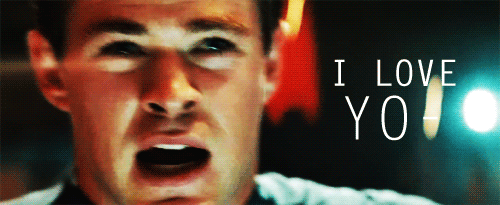
In a scene which is elevated by pacing, the performances from both Hemsworth and Morrison, as well as Giacchino’s touching score, this scene breaks my heart a lot more seven years later than it did in 2009. Granted I’ve dealt with more loss (some of it pretty recent), so maybe that’s why I teared up. As an adult the scene strikes a deeper chord with me. It sets up the loss Kirk has to live with and the sacrifice of his father which will weigh on his shoulders for the first three of these films. It is an excellent introductory scene into the film and - in one specific line - even shows just the love and respect this film pays to the original.
George [after Winona suggests naming him after his dad]: “Tiberius, are you kidding me? No that’s the worst. Let’s name him after your dad. Let’s call him Jim.”
7) JJ Abrams has a lucky charm in actor Greg Grunberg, who makes an auditory cameo in this film as Kirk’s stepdad via radio. Abrams includes Grunberg in almost all his films (he is notably absent in Star Trek into Darkness) and the pair have known each other since Kindergarden.
8) Young Kirk and Spock.
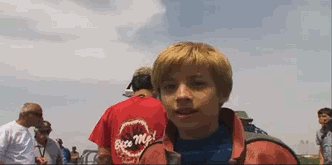
The initial scene with an adolescent James T. Kirk shows off his conflict quite well. He’s a rebel. Much more than Shatner’s Kirk-Prime and that is saying something. Closer to Han Solo than a Starfleet captain, he is dealing with the pain in his life and the constant lowered dismissal of others. No one expects anything of him yet as the film goes on he grows more and more confident in himself and trying to do what’s right. It’s a wonderful conflict and journey we get to go on with this character.
Much like Kirk, Spock’s initial conflict is introduced brilliantly in his initial scene. There is a dissonance between his human half and his Vulcan half I have not seen in any of the media before (I’ve never watched The Original Series, so maybe it’s in there). But the deep examination of these two halves and the conflict it brings about in Spock is a wonderful arc for the character to go on throughout the film, helping to lend it its epic feel.
10) I don’t understand Vulcan bullies. What part of bullying is logical? Assholes.

11) This line from Spock’s father is very illuminating of the Vulcan culture, in a way which surprises and delights me.
Sarek: “Emotions run deep in our race. In many ways more deeply than in humans.”
12) Winona Ryder as Spock’s Mom.

If you’re wondering why someone as young as Winona Ryder is aged up and playing Spock’s mother, there is actually a reason for it. There’s a deleted scene in the film featuring her giving birth to Spock where she is not aged up at all.

From the very start of Ryder’s brief appearance in the film we understand their relationship. We see just how deeply the pair are connected and how much Spock loves his mom. It lends to the humble pride he takes in his human half as well as the sorrow which is to come.
13) Vulcan’s are supposed to be purely logical creature, so why the hell are they so freaking racist?
Vulcan Council President: “It is truly remarkable, Spock, that you have achieved so much despite your disadvantage. All rise.”
Spock: “If you would clarify, Minister: to what disadvantage are you referring?”
Vulcan Council President: “Your human mother.”
Although I must say that Spock sass is the best.
Spock: “Council... Ministers, I must decline.”
Vulcan Council President: “No Vulcan has ever declined admission to this academy!”
Spock: “Then, as I am half-human, your record remains untarnished.”
14) Zachary Quinto as Spock.
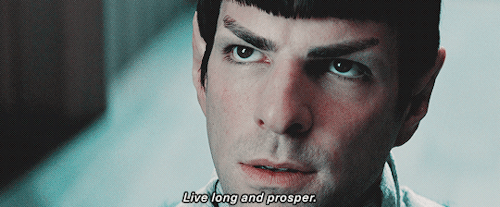
It is incredibly hard to fill the shoes of any of these characters, but Spock was probably the most difficult to cast. Leonard Nimoy’s portrayal is iconic not just in the realms of sci-fi but across cinema in total. Yet Quinto does a fantastic job in the film. He is able to create a Spock which is unique unto itself, taking the opportunity given by Spock’s identity conflict in the writing and take it to its full potential. We see Spock’s sorrow, his pain, his intellect, his logic, his emotion, all of it is present throughout the film in a wonderful balance orchestrated by Quinto’s performance. The audience is never distracted by the fact that this isn’t Leonard Nimoy, even when Nimoy himself shows up later in the film. This is Spock. New, fresh, unique Spock.
15) Chris Pine as Kirk.

Pine’s performance - in lesser hands - could have just been a really bad William Shatner impression (which he showed off on “SNL” a few weeks ago). But like Quinto, Pine is able to take the new conflict featured in the script and make Kirk his own. He makes the character much more roguish, taking him a different direction that Shatner and creating a future-captain who feels knew and fresh. This is still a portrayal which is worthy of the name James T. Kirk: he cares about his crew, he pushes things to their limits in an effort to save the day, he’s a fundamentally good man. But add to that a heavier amount of pain from the death of his father as well as an inclination to rebel and you have a career making performance from Pine.
16) Zoë Saldana as Uhura.

Having my experience with Uhura only be the films and not the original series, I actually really prefer Zoë Saldana’s Uhura to Nichelle Nichols’. Not based on their performances, I think Nichols made Uhura iconic. But because I think the writers make Uhura much more active in the rebooted timeline than she was in the original films. She’s a bit sassier, a bit more of a fighter, and much more inclined to call people out on their shit. Saldana is a gem in any and all movies she is featured in (See: Avatar, Pirates of the Caribbean: Curse of the Black Pearl, Guardians of the Galaxy, The Book of Life, The Terminal) and her role as Uhura is no exception. I fell in love with her as an actress because of this film and I am forever grateful for that.
17) Kirk is also someone who actively seeks out fight more than Shatner’s Kirk did, I feel.
Starfleet Cadet [after Kirk is being a pill to them]: “There are four of us and one of you!”
Kirk: “Then get some more guys and it’ll be an even fight.”
[Kirk gives the cadet a pat on the cheek before getting his ass kicked.]
18) Having watched all of the films with the original cast now, I see much more of the respect and love the filmmakers have for them than I did back in 2009.
Captain Pike: “Something I admired about your dad: he didn’t believe in a no-win-scenario.”
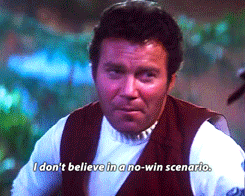
(GIF source unknown [if this is your GIF please let me know].)
19) Kirk is also someone who enjoys defying the expectations others set for him, even if it is more for his benefit than their’s.
Kirk [after Pike says he can have his own ship after 4 years Starfleet]: “Four years? I’ll do it in three.”
20) Karl Urban as Bones.

I remember reading (but can’t find) that Leonard Nimoy found Urban’s performance as Bones so spot on similar to the late DeForrest Kelly that it brought him to tears. That right there tells you a lot about the portrayal. Urban is in my not-so-humble opinion the finest character actor in cinema right now, and even though he plays Bones closer to what he has always been (compared to the rest of the cast) that is never distracting. Kelley’s performance is a clear influence on Urban but he is still a character, not a caricature. He is able to both keep Bones the same character he’s always been without it being distracting and I love him for that. There are so many actors who I now love in film after I first saw them in this.
21) Eric Bana as Nero.

I might not be able to say this objectively, as this was my first experience with Star Trek, but I think Nero is an incredible villain and that Eric Bana is transformative in the part. Nero is not like the villains we’ve had in the past. He is not genetically engineered or trained for tactically superiority. He’s a miner from the future. He’s a blue collar worker with no military experience, driven mad by an incredible grief at the loss of those he loves (something both Kirk and Spock deal with in this film). Bana is able to portray this madness, this vengeance with incredible devotion. You don’t see Bana, you only see Nero.
22) Ah, the test...
Bones: “Jim it’s the Kobayashi-Maru. No one passes the test!”
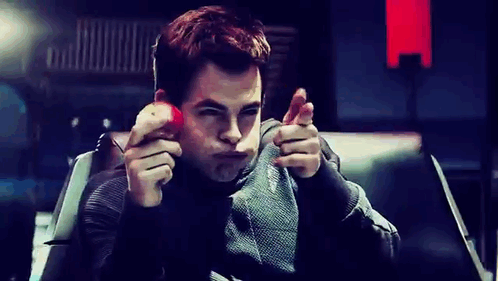
Using the concept of “show don’t tell” to it’s full advantage, taking what was only mentioned in Wrath of Khan and showing just exactly how Kirk cheated on the (in)famous test. Although in that film he said he, “Got a commendation for original thinking,” whereas here he is given academic probation and held before a council hearing (which seems a bit extreme to me but whatever). Also, according to IMDb:
In the scene where Kirk is taking the Kobayashi Maru test, he is eating an apple, which is also what he is eating while recounting his tale of taking the Kobayashi Maru test in Star Trek II: The Wrath of Khan (1982). (According to director J.J. Abrams in the DVD audio commentary, this was not intended to be a reference to The Wrath of Khan. At one point, he was simply told that lead actors seem cocky eating apples.)
23) This was Tyler Perry’s first movie role outside of his own projects (according to IMDb). That’s all. Moving on.

24) There is this incredible and deep conflict between Kirk and Spock which I love to see turn from adversary to friendly.
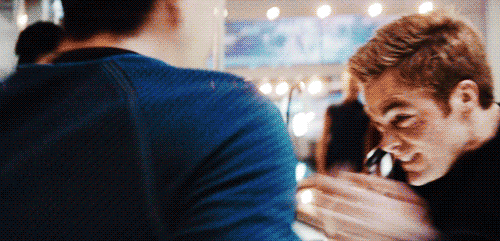
These two are famously best friends and I don’t know that we’ve ever seen them so at odds with each other. They freaking hate each other. They disagree with each other and each other’s methods on EVERYTHING. It is only through this conflict, through pushing each other, and through the trials the movie puts on them that they are able to respect and admire one another. I freaking love enemies-to-friends in movies and I’m so grateful they did that for this one.
25) John Cho as Sulu.

To start with, the fact that we are re-introduced to one of the most experienced pilots in science-fiction by having him make a mistake is a strong way of differentiating Cho’s Sulu from Takei’s Sulu. It helps to remind us just how green the crew of the Enterprise is in this movie and sets up the journey to come. I really like Cho as Sulu and I think he’s great in this film. You see him as someone who’s a little more unsure of himself early on and grow into the assurance that Takei had. But I also think he has some great moments to shine in Star Trek into Darkness and Star Trek Beyond, maybe more so than the rest of the crew, so this is not the last you will be reading of Sulu.
26) Anton Yelchin as Chekov.

I will talk about Yelchin’s unfortunate passing last year when I write my recap for Star Trek Beyond soon, but I will say that I miss his presence in film. Yelchin is able to make Chekov such a youthful and fun character. He’s only 17 and is eager/excited to be on this ship. He’s smart, enthusiastic, optimistic, and able to serve to the fullest of his capabilities. In some ways more so than the rest of the cast (and I know this is blasphemy to old school Trek fans) Yelchin will always be Chekov to me (more so than even Walter Koening). I’m gonna miss him in future films.
27) The scene where Kirk is running around the Enterprise is great for me.

Not only is there some intense physical humor with the continuing set of symptoms Kirk is going through and the constant amount of shots Bones gives him...
Bones: “You got numb tongue?”
Kirk [with his mouth full]: “Numb tongue!?”
Bones: “I can fix that!”
But it also shows off Kirk’s intelligence. When he puts aside the bullshitting and the need to rebel he is the captain we all know him to be. He KNOWS they’re heading into a trap and it’s not just a bullshit feeling. Even though Spock and Captain Pike all write him off at first Kirk FIGHT to be heard and he is. He is confident and demands to be listened to, earning the respect, trust, and belief of the crew (even if temporarily). He trusts Uhura’s skills in xeno-linguistics, he read Captain Pike’s paper on his father’s death, he even gets Spock to agree that his logic is sound. It is this moment when he starts on his journey to becoming captain of the Enterprise.
28) This is an interesting parallel with Spock and Kirk’s father.
Captain Pike [after Spock wonders if making Kirk first officer is a prank]: “It’s not a prank, Spock. And I’m not the captain, you are.”
The obvious choice would be to have Captain Pike utter these words to Kirk but his using them with Spock is a nice deviation from expectation.
29) Olson is wearing a red shirt/suit.
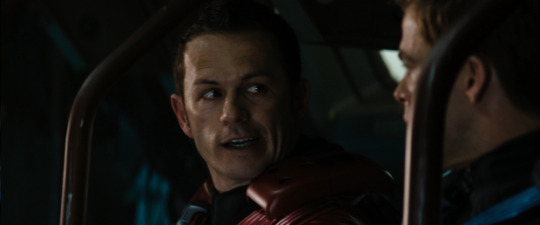
In the original series, a “red shirt” was a character who’s role was primarily (often exclusively) to die horribly to show just how real the danger was.
30) I think the fight Kirk and Sulu have on top of Nero’s drill is not only a great action scene, but helps build the relationship between the two in a not so obvious way. When Sulu falls off the drill Kirk jumps after him without hesitation and then it is Chekov who pulls their ass out of the fire. It is a moment of deep trust between the Kirk and Sulu (and even Chekov) which will help the pilot get behind Kirk as captain later in the film.
31) Under the trivia for Galaxy Quest (the 1999 Tim Allen film) on IMDb:
In the Audio Commentary for Star Trek (2009), Director J.J. Abrams says, "By the way, I think we've all gone on record as saying one of our favorite 'Trek' films is 'Galaxy Quest'. And this sequence [where Kirk and Sulu are falling toward Vulcan without a parachute] is clearly an homage to Tony Shalhoub's great save in that film."
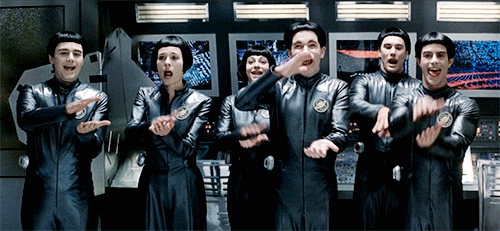
32) Spock’s struggle with the destruction of Vulcan and the loss of his mother ties directly into his conflict of identity. The universe needs him to be a Vulcan much more than it needs him to be a human now as he is now a member of an endangered species (and even identifies himself as such). And Vulcan’s try to outweigh emotion with logic, meaning that he is burying the grief he feels over his mother’s death in a way which is totally unhealthy.
33) I might be in the minority, but I like the Spock + Uhura relationship.

In some ways I wish it were developed more in future films, but I like how it is a quiet part of their relationships. You can tell it is based on deep compassion they have for each other as well as a total trust. They respect each other fully and never underestimate they other. There is no deception in their relationship, it’s just them. And I think Quinto and Saldana portray this wonderfully.
34) This version of Spock does not make a good captain. It is probably because he is trying to bury his emotion with an overcompensation of logic, but logic is only the beginning of wisdom and just because something is logical does not mean it is right. A lesson he has yet to learn.
35) And THIS is why this reboot works as well as it does.
Uhura [after Spock explains what the ramifications of Nero’s time travel means for them]: “An alternate reality.”
Spock: “Precisely.”
By creating an alternate reality which exists separately from the original timeline you are able to have more freedoms with your story. It is not a full on prequel or reboot. It very much respects what has come before it while clearing the way for something new to come. THAT is why - in my personal opinion - this is the best reboot of a series ever. And a method that X-Men and Terminator have tried to duplicate with varying degrees of success (X-Men doing it well, Terminator not so much).
36) Leonard Nimoy as Spock-Prime.
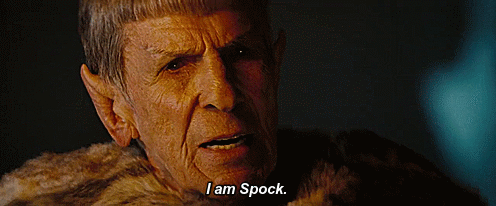
Now that I have seen the original Star Trek films with Nimoy his appearance in this movie carries a lot more weight for me. When I saw this in theaters the audience freaking cheered when Spock showed up as it was almost a total surprise, meanwhile I had to double check with my father that he was who I thought he was.
Spock: “I have been and always shall be your friend....I am Spock.”
[Beat.]
Kirk: “Bullshit.”
(Kirk’s bullshit made me laugh so freaking hard the first time I saw this.)
Nimoy is great in this film and passes the torch in an incredibly respectful and heartfelt way. It is a nice juxtaposition to see this wiser Spock with Quinto’s greener one and Nimoy is at his best in the part. According to IMDb:
Roberto Orci, Alex Kurtzman and J.J. Abrams personally called upon Leonard Nimoy's home to request for his role in the film. According to Orci, the actor gave a "Who are you guys and what are you up to?" manner before being told how important he was to them. He was silent, and Nimoy's wife Susan Bay told the creative team that after their conversation he had remained in his chair, emotionally overwhelmed by his decision to return as Spock after turning down many opportunities to revisit the role. He decided to act in this film as he was turned on by the script's scope and its detailing of the characters' histories: "We have dealt with Spock being half-human/half-Vulcan, but never with quite the overview that this script has of the character's entire history, his character growth, his beginnings and his arrival into the Enterprise crew."
It is also through Kirk’s brief time with Spock-Prime that he learns truly who Spock is. He sees him at his most vulnerable, at his most trusting of Kirk since to him they are old friends. And he knows that’s in Quinto’s Spock and he respects him a bit more for it, even if that respect is not apparent upon their initial reunion.
37) Simon Pegg as Scotty.

(GIF originally posted by @stnetwork)
I like how Scotty is included in the plot. It feels more organic and makes him a bit different. He’s not like the rest of the crew who we met in the academy and on the Enterprise. He shows up when he’s needed and Simon Pegg is great in the role. A major fanboy, Pegg is absolutely hysterical in the part. You can clearly see the James Doohan influences in the role but Pegg - like the rest of the cast - is able to make the part his own and fit in with the rest of the crew perfectly.
38) I freaking love this.


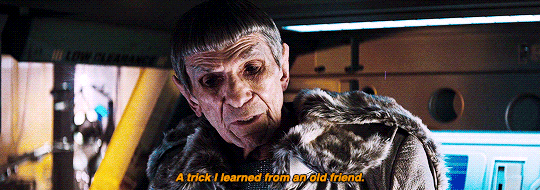
(GIFs originally posted by @zacharysquinto)
39) Beaming Scotty and Kirk on the Enterprise only for Scotty to end up in the water tube illustrates a simple rule in storytelling: always have things go wrong. It’s more interesting that way.
40) Kirk pushing Spock is incredibly powerful for me, because Kirk does not enjoy doing this. He does not want to do this. Despite what animosity they may have towards each other, Kirk is only doing what is right. What Spock-Prime told him. He is doing what he has always done: what is best for the crew of the Enterprise. But that doesn’t mean he’s so sure of himself.
Uhura [after Kirk takes the captain’s chair]: “I sure hope you know what you’re doing, captain.”
Kirk: “So do I.”
41) And then the crew starts to take their places. They come together to go against Nero in a way that is reminiscent of the original series.

This image also reminded me of Kirk’s costume: he is the only one not in uniform until the VERY end of the film. He’s the black sheep of the crew who grows into his role.
42) There are a few small moments in the scenes to come which show how Kirk is already filling his duties as Captain. Namely: his telling Sulu to fire on Nero’s ship even if he and Spock are still on it/his covering Spock on Nero’s ship without hesitation (despite the conflict they’ve had up until this point).
43) Remember how I said you should have things go wrong whenever possible?
Scotty: “If there’s any common sense to the design of the enemy ship I should be putting you somewhere in the cargo bay, shouldn't be a soul in site.”
[Kirk and Spock are beamed onto the enemy ship in plain sight of the crew and are immediately attacked.]
44) Similar to Khan (since, for better or worse, Khan will be the villain all other Trek villains are compared to), Nero let’s his need vengeance leave him open to vulnerability.
Romulan Crew Member [after Nero has ordered them to fire on Spock’s ship]: “Sir, if you ignite the red matter -”
Nero: “I WANT SPOCK DEAD NOW!”
45) This was always my dad’s favorite line in the film.
Ayel [Nero’s secondhand]: “Your species is even weaker than I expected. You can’t even speak. [Kirk, who is being choked by Ayel, chokes something. Ayel pulls him closer] What is it?”
Kirk: “I got your gun!”
[Kirk grabs Ayel’s gun from his belt and shoots him.]
46) And Spock makes peace with his human side.
Kirk [after offering to rescue Nero, the man who killed Spock’s mom]: “It’s logic Spock, I thought you’d like that.”
Spock: “Not really. Not this time.”
47) The entire final escape from the black hole ties in not only to the idea of making things go wrong whenever you can, but also an idea found in many Hitchcock films: it’s never over when you think it is.
48) Spock & Spock-Prime.

The only scene the pair share in the film, it is also an incredibly impactful one. A true passing of the torch, Spock Prime is able to share more than logic with Spock. He is able to share his wisdom and help guide Spock down a path as fruitful as his was. It’s a wonderful moment that the film truly needed and that I am forever grateful for.
Spock Prime: “As my customary farewell would seem oddly self serving, I shall simply say good luck.”
49) The end of this film could easily have been just that: the end. The series could have stopped here and it would have been a wildly satisfying ending. Leaving the future open for hope and opportunity, but also getting these characters in the places we are familiar with. Leonard Nimoy does the iconic monologue for the film, and Michael Giacchino incorporates in his ending score his own theme as well as Jerry Goldsmith’s theme from Star Trek: The Motion Picture and the original television show theme. It is just a wonderful ending.
Star Trek is epic. It analyzes the characters and their relationships with a depth not yet explored in the series, specifically with Kirk and Spock. Abrams directing yields some beautiful imagery and the acting is absolutely phenomenal. At its core this film is a big fat love letter to the original series and the hope it brings, paying that hope forward to a new generation who (like me) find these characters through this film. I love it, with all my heart I love it.
#Star Trek#Chris Pine#Zachary Quinto#Zoe Saldana#Leonard Nimoy#JJ Abrams#Simon Pegg#Karl Urban#John Cho#Anton Yelchin#Eric Bana#Greg Grunberg#Epic Movie (Re)Watch#Movie#Film#GIF#Galaxy Quest#Tyler Perry#Jennifer Morrison#Winona Ryder#Chris Hemsworth
10 notes
·
View notes
Text
Far Cry 5: For Preppers, Cults and Blazing Guns
»Something is coming. You can feel it, can’t you? That we are creeping towards the edge… and there will be a reckoning. That is why we started the project. Because we know what happens next!«
Just imagine someone preaching these words to you. Over and over and over again. Painting a picture of a damned and unavoidable tomorrow none of us are prepared for. And then … imagine this very same person offering you the solution to all the things you might be scared of by now – how would you react? We sat with Dan Hay, Ubisoft‘s driving force behind their most recent blockbuster »Far Cry 5« and talked about a fictional Montana, preppers, cults and doomsday fiction, that – strangely enough – actually doesn‘t seem that unrelatable once you hear it for yourself.
Growing with the Brand
As Executive Producer, Dan has not only been with the Far Cry brand since »Far Cry 3«, he was also the Creative Director on »Far Cry 5«. Since 2011, he was actively involved in the work on »Far Cry 3«, »Far Cry: Blood Dragon«, »Far Cry 4« and the exotic spin-off »Far Cry Primal«. So let‘s start easy into the conversation – how about Dan‘s most favourite thing about his team‘s latest release?
»Aah, it‘s always questions like those that get you. Most of the time, interviews start like ›Okay, tell me about your game!‹ and you‘re like ›Oh, well, okay, this and that.‹ (laughs). Well, generally I’m a gamer and I love to play video games. So, based on that, when you ask specifically about Far Cry 5, the thing that I like the most is that I always discover something new. When we started to build the game – and this is not just some bulls$%t producer answer – we tried to achieve something that is capable of always surprising you as a player. You are choosing your own adventure and this always has a big effect on your experience. As an example, I have a pretty earnest and story-focused way of playing, almost like watching a movie, but with Far Cry 5 we created the exact opposite and I love that. The essence of the game is what you make of it. If you would like to dive into the story, you can totally do so. But you can also decide to go fishing for a while, if you feel like it. When I think about E3 last year, we had these super earnest moments that we prepared with the character Nick Rye, and at the end of the day we just watched players go off and fish for three hours (laughs). That’s totally okay, great even. Play the game how YOU want to play it. The fact that it still manages to surprise me, even though I worked on it and I played it six times already, is by far my most favorite thing.«
After an arrest gone wrong, players need to liberate Hope County from Joseph Seed and his followers – unsurprisingly, it can get pretty messy.
Switching between Roles
Being the Creative Director of a behemoth of a game like Far Cry 5 in addition to managing the whole brand as Executive Producer, Dan not only has to ensure the brand‘s success, but the development process to remain healthy as – all of that while juggling a wide range of responsibilities.
»From my personal standpoint, as a Producer you really have to focus on the day, on the date, and on the team. You have to make sure that everybody on board is rowing in the same direction. At the same time, you’re not necessarily involved into the everyday developing process. You take somebody else‘s vision and your task is to make sure that it is executed in the best way possible. As a Creative Director, you have to use a completely different ›pair of muscles‹. You care about everything, and sometimes even too much.
Also: I feel like Producers are the ones that people complain to, while Creative Directors are the ones people complain about. And I can totally understand that, because you put so much effort into your game and you want your baby to come out and just be perfect. The thing is: you need both roles! You need someone who is absolutely and with his full heart invested in the process, just as much as you need someone who has the ability to be completely impersonal to it. It’s a very tricky thing and I can tell you it’s super hard to do it as only one person. Luckily, we have some very talented people in our team. It‘s existential to have people who kind of pull you in and are able to question ideas: ›What is the player going to get from this?‹
The key behind it all is that no matter how many ideas you have in your head of how the game should be, always put in the playtest. Let players play your game and they will tell you what they want.«
It’s all about the decoration: The Eagle Spread Saloon is one of the many key locations players need to liberate over the course of the game.
American Backlash
What may sound like a song from Kid Rock, was actually a reaction to Ubisoft‘s first reveal of Far Cry 5‘s villain Joseph and the cult that blindly stands behind him. The studio received a letter by people who furiously demanded the villain to be changed and even started a petition. The villain, a seemingly average man who gathered his flock by preaching psalms and Armageddon to a crowd of so-called »preppers« who fear that the end of the world is near and who suddenly found a leader they could blindly follow to guide them through a non-existent crisis. Joseph Seed, however, doesn‘t represent the enemy image we‘re used to by now – he‘s just a regular Caucasian man.
»I think that you will always trigger reactions like this,« Dan elaborates, »when you start to talk about any sort of ›unexplored‹ topic. Let me say it this way: movies have now been around for more than a hundred years. I think it was something around 1890, when the first movie was captured. The medium ›film‹ has the Oscars. It had such a long period to evolve and grow, and – most importantly – to explore different subjects. If we now take the stand of games, there is still a group of people who think that we are small and still in our infancy. No, we‘ve been around for like 50 years! Now think about the Oscars again, which were established in 1929. Pong has been released in 1972, and I know there were already earlier games, but that is 46 years ago. I think we can explore stories. When you touch uncommon topics, there are going to be people who love it, people who are concerned about it, and of course people who don’t like it. You will run the whole gamut of expressions. All this tells me, is that we finally arrived. We are mature!«
Thanks to photogrammetry, the world of Far Cry 5 – Hope County – looks absolutely breathtaking, be it the woods, lakes and rivers or buildings.
An adequate Approach
Looking at the shere size of a game like Far Cry 5, one may wonder how to even start a project like this. Go for the setting first, then build everything on top and around it?
»The circumstances under which Far Cry was created, are super interesting. Normally, when you work on a franchise – and I worked on a few in the past – you first try to elaborate its fundament. What was its creative core, what its type of gameplay? If you are finally done with that, you can look at the package you have and form it the way you want it to be in the future. Far Cry is certainly different, no question, especially when you look at the gameplay systems like our ›Anecdote Factory‹ and many others. However, what the brand manages so extraordinarily well, is that each individual game is it’s own thing. Right now, we have a lot in common with TV-Shows like ›The Twilight Zone‹ or ›Black Mirror‹. We want different directions and we want different explorations. The experience that can give you Vaas Montenegro, the antagonist of Far Cry 3, is clearly not the same you will get from playing Far Cry: Blood Dragon. The way that Pagan Min from Far Cry 4 will make you feel, is certainly different from the experience made in a Far Cry that takes you you 12,000 years into the past… which really nobody saw coming,« Dan laughs. »Then you jump forward to Far Cry 5. I think, that‘s what makes the brand so special. For a brand that big, it‘s remarkably nimble. We always try to include three major aspects: freedom, opportunity and surprise. The freedom to go wherever you want to go, opportunities that are bound to the world, and surprise that is created by the various systems and encounters we implement into the game. When they bite back, they will do so in a way you didn’t expect it.«
»… and the Holy Father«
Looking at how the brand evolved, especially since Ubisoft took over, there wasn‘t a single memorable hero, which already tells you a lot. The villains however… well, while »Uncharted« and »Tomb Raider« put Nathan and Lara on their box-arts, Far Cry‘s covers were not only dominated by each game‘s villain – be it Vaas, Pagan or lately Joseph and his crazy flock, imitating the last supper –, the actual hero wasn‘t even mentioned.
Considering that it goes without saying, that the task of creating another iconic villain wasn‘t only hard, but immensly stressful as there was always a certain risk of repeating what had already been done.
Joseph Seed and his leutenants know how to convince the inhabitants of Hope County to say ›YES‹ and join the cult.
»The stress level was ridiculously high,« Dan laughs. »The first thing everybody does is asking about the villain, even within the team. The biggest problem was that we set the game to be so wide and generous that we had a massive casting to do. We had to get all the communities, all the people in these communities, the ›Guns for Hire‹ and so on. We got all the actors coming in and started to work, until at some point, people asked ›Great, cool! So what’s going on with the Father?‹ – and there is nothing we could tell them except ›We‘ll get there!‹ And we found our actors for John (Seamus Deever), Faith (Jenessa Grant), and Jacob (Mark Pellegrino). And we’re getting more and more stressed while realizing ›Holy S&§%! We’re not getting the Father!‹
You know, I can hold a debate for a while. I can talk my way through it, but that wasn’t happening. We were testing people, but it wasn’t landing. I didn’t believe that these people could talk me out of my life and into theirs – but that was exactly what they needed to prove, right? Prove to me, that they can take me away from my family and that I would join their cult. I was freaking out. I wasn’t telling anybody, but I was freaking out!
Finally, one day – but weeks too late – someone came to me and touched me on my back, saying ›Come here, you need to watch this‹. I was trying to tell him that I’m busy and didn‘t have the time right now but he was again telling me to sit, literally forcing me to watch this video. So I put on the headphones and it was Greg Bryk doing a self-tape with our Animation Director. He just started to talk, and after about 30 seconds, the hair on the back of my neck stood up. He just talked about how the world could end and how it’s just reasonable to prepare. He was talking about the end of the world and by doing so, he was not making any argument that seemed like nonsense to me. He explained what was happening in the world right now, and that even if I have a plan of doing something about it, what was going to happen if wasn‘t working out the way I thought. There is an opportunity, and I’m the one who is not prepared! And without hesitation I thought that he was right, because everything sounded just so plausible. In the next moment, I realized that he actually had just talked me out of my life – in only 35 seconds! We knew that we needed to bring this guy in, so we did. Greg is such a sweet, normal guy. Maybe a little spooky,« Dan laughs out loudly. »But the most important thing is, that he‘s so magnetic. We were having lunch and were just chatting, when at one point he leans over to me (Dan stands up and leans towards us to reenact the scene) and whispers ›I just want you to know I’m comfortable with violence‹, waits a moment and leans back to return to his steak…
Greg is from my hometown. We got to know each other pretty well and I think he is incredibly talented. The second day that I knew we were safe, was on the set. We hadn‘t shot a lot of the father stuff, but we did with quite a lot of the other actors. The crucial proof was, that he wasn‘t only magnetic on his own, but that he was also capable of bringing this synergy to life within the group. After they yelled ›Action!‹, Greg went over to the other actors and he just owned the space. We watched it in motion capturing and we so hoped that we could keep this energy!«
Maybe he wasn‘t acting… »He‘s super talented,« Dan starts laughing again, »but it comes from a dark place!«
A Montana, so fictional and real
In preparation for the work on Far Cry 5, Dan and the team took a road trip to Montana to see for themselves what these prepper cults were actually like.
»I think the most interesting thing about it was, that you go such a place with a certain prejudice: somebody is preparing for the end of the world, and of course everybody thinks this doesn’t make any sense at all. But when you meet them, you realize that these are just normal people like you and I. You have normal discussion with them, about their favorite baseball team or whatever. At some point, however, you get to an area of their life that is not that relatable anymore, that is different from yours, and when they start to talk about their way of thinking, it doesn’t sound crazy, it’s just prudent,« Dan explains. »The weird thing is, that after a while you start to question yourself: ›Why am I not doing this? Maybe preventing is a good thing!‹
All I know is that working on Far Cry 5 has changed my perception of what I need to get around and it changed my perception of how I operate.«
Also the way he does games? »I think so, especially by taking something that primarily has been a single player adventure and infusing it with these now new voices like Guns for Hire and the communities, who you can take along. That has changed the language of what you are hearing and seeing tremendously. Players are really responding to it and I think that‘s something we want to elaborate on in the future and make sure that there are other new voices.
In addition, we implemented our newly developed interaction system, which most likely nobody really notices. For example: if you go to Nick Rye, we as the developers have no clue if you have company like Guns or Fangs for Hire. We don’t know at what time you are going there, if it‘s 9 o‘clock at night, or 6 o‘clock in the morning, right? Said system makes NPCs react in a more relatable way, which in turn makes the world and its inhabitants feel way more realistic.«
A Place, never to be seen
Be it in terms of villains, settings or even time periods – Far Cry already proved that nothing seems to be unlikely. And still we wanted to know if there‘s any setting Dan would love to realize, but which fans will most likely never ever see in any episode of the series.
»That is a good question…,« Dan sighs, »but I’m not going to give you my answer on the ›where‹, because I think there is no setting that will ›never happen‹. As I said at the beginning, I think that Far Cry‘s biggest strength is its nimbleness. People told us we couldn‘t go 12,000 B.C., and we did!
As for Far Cry 5, I remember being in a meeting at an early developing phase and telling the others that I’d really like to go to the states. Somewhere beautiful and rugged. Someone in the team responded by saying Montana. ›Why the hell Montana?‹ everyone thought, but that was exactly what made it so interesting: the reaction of the others. Can we go to space? I don’t know – maybe? I think it would be interesting. People are playing the game right now, and the best compliment I got was ›That should be an HBO series. The opening is so powerful, you should take that to HBO!‹ So my point is, I don’t feel like there is anything we can’t do. The tricky part is, when you pitch something. What you don’t want to do is make the mistake of not having a majority of questioning people. Sure, we could rush into realizing an idea and make something, but that is just a reaction. I want to sit down and think about it, question it. Where can we go that nobody expects? I think it‘s intriguing and our brand does that better than most, while still being plausible. We want people to feel like there is an echo of somebody you know.
That is what I meant when I was talking about Montana. We met people that were fantastic and I totally loved the place. People were generous, I could even imagine to retire there. But one should not forget that some of these folks live a lifestyle that is just so different from ours. More of a survivalist and rugged, almost explorational lifestyle.
I think, Far Cry as a brand has it in its DNA, so the question is not where we want to go, but rather what we do when we arrive. We want to make you feel like this is something you can connect to, something you might have done, almost like a memory. It’s tricky – but who ever said it was going to be easy?«
Dan Hay
is Executive Producer
and Creative Director at Ubisoft Montréal
Dan began his career in TV and film roughly 18 years ago. During that time he worked as a modeller, texture artist, lighter, animator, lead animator, lead lighter, and commercial animation director for numerous commercials and films. He made the move to games 13 years ago and has served as cinematic director, art director and producer on multiple titles. His credits include »Far Cry Primal«, »Far Cry 4«, »Far Cry 3«, »Far Cry 3 – Blood Dragon«, »F.E.A.R. 3«, »Wolverine«, »Fracture«, »Marvel Ultimate Alliance«, »Quake 4«, »X-Men Legends«, »X-Men Legends 2: Age of Apocalypse «, and »007 Nightfire«. Dan credits a steady diet of comics and movies with pulling him into the industry.
The post Far Cry 5: For Preppers, Cults and Blazing Guns appeared first on Making Games.
Far Cry 5: For Preppers, Cults and Blazing Guns published first on https://leolarsonblog.tumblr.com/
0 notes
Text
Bill DeWitt Is Not Your Friend
By Chase Woodruff
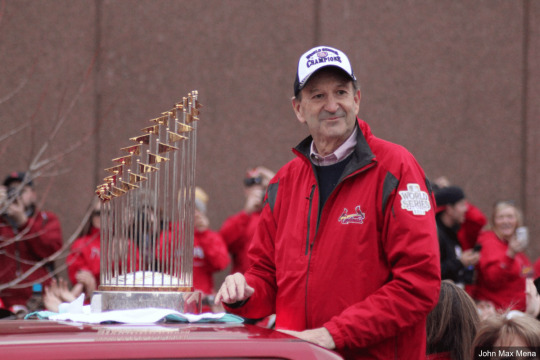
One year ago next week, St. Louis sports fans had their hearts ripped out of them by a grotesque Thomas Nast cartoon of a team owner. Stan Kroenke, a wigged weirdo who’d lucked into his fortune as a tapeworm in the intestines of the Walton family, persuaded a roomful of equally talentless and vicious old men—silver-spooned dilettantes, gout-ridden oligarchs, adjudged fraudsters, Dan Snyder—to let him do it. They did it out of greed, they did it because they could, and they did it with a sociopathic disregard for the people they’d lied to, extorted, and spat on in the process.
Not long afterwards, the Blues played the Hurricanes, and before the game Bill DeWitt III, president of the Cardinals and son of majority owner Bill DeWitt Jr., joined Blues chairman Tom Stillman for a ceremonial puck drop. Fans cheered, but mostly they chanted: “Kroenke sucks, Kroenke sucks, Kroenke sucks.” It was a cool moment.
It was also the beginning of a deeply bizarre consequence of the civic trauma that Kroenke and his fellow NFL owners had put St. Louis through: a renewed, unconditional reverence for the men who owned the city’s two remaining franchises. Stillman and the DeWitts were suddenly “the Anti-Kroenkes.” Local media hailed their “show of solidarity,” their “St. Louis pride,” their “support for St. Louis and its fans.” On Twitter, the praise went on and on: “classy owners,” “class acts,” “pure class,” “world class,” “the definition of CLASS,” “more class in their toenail clippings than Stan Kroenke & Jerry Jones ever dreamed of having.”
Rather than come away from the Rams ordeal with a vivid understanding of the ugly truth about the relationship between fans and owners, many in St. Louis seemingly just wanted to feel good again—to believe that the experience revealed nothing at all, to be comforted by the idea that Kroenke was just an anomalous supervillain and that nothing bad would ever happen again. The Cardinals’ and Blues’ PR departments, along with plenty of local journalists, were happy to oblige. This went on all year, most notably throughout the announcement, promotion, and staging of last week’s Winter Classic; it will certainly last through Sunday’s closing-ceremonies event at Busch Stadium, and probably for a long time to come.
Even if this instinct is understandable, it’s also wrongheaded and dangerous. The unlikelihood that Bill DeWitt will ever do something as deceitful and as damaging as Stan Kroenke did doesn’t mean we shouldn’t hold him, and all other team owners, to a higher standard than simply not being Stan Kroenke. Whether it’s the Cardinals, the Blues, a future MLS team, or anything else, it’s our responsibility to assess individual owners on their own merits—to look at facts, data, and the historical record, and judge them on the evidence.
Major League Baseball was in rough shape in 1995. A quarter century of labor strife, set against the backdrop of widespread doomsaying prompted by the rise of the NFL, had culminated in the costliest work stoppage in the history of professional sports. Television networks, bitter over lost revenue, deserted the league. When play finally resumed, fans took their anger out on owners and players alike. Ratings and attendance plummeted.
The situation in St. Louis, one of the game’s traditional strongholds, was especially dire. The Cardinals hadn’t made the playoffs in eight years and, as a small-market team highly dependent on gate revenue, had been hit particularly hard by the post-strike attendance drop. In October, Anheuser-Busch shocked the city with the announcement that it planned to sell the team after more than forty years of ownership. The brewery, which claimed the Cardinals were losing tens of millions of dollars annually, pledged that it would sell only to buyers who were committed to keeping the team in St. Louis, but many fans weren’t convinced.
Within a few months, however, their fears were assuaged. A new ownership group with local roots swept in to purchase not only the team but also Busch Stadium II and its surrounding parking garages for a total of $150 million—a price tag that fell significantly below expectations, which had already been low given the league’s financial woes.
Perhaps quite purposefully, the ownership group was initially presented as a triumvirate of sorts, with Drew Baur, Bill DeWitt Jr., and Fred Hanser comprising the principals. Baur, a local bank executive, and Hanser, a partner at Armstrong Teasdale, were established members of St. Louis’ elite; DeWitt had been raised there but made his home (as he does to this day) in Cincinnati. His father had been an executive and owner of both the St. Louis Browns and Cincinnati Reds, and DeWitt fils had himself owned minority stakes in the Reds, Texas Rangers, and Baltimore Orioles, which he’d narrowly missed out on buying a few years before Anheuser-Busch put the Cardinals up for sale.
Even at a cut-rate price, many investors cast a skeptical eye towards the deal, citing baseball’s “downhill slide” and declining real estate values in downtown St. Louis. The new owners seemed to lean into this idea, declaring themselves “fans…interested in owning one of the great franchises in history,” rather than businessmen simply out to make money. “Each member of this group,” Hanser told the Post-Dispatch in January 1996, “could find a better economic investment than the St. Louis Cardinals.”
Whether or not Hanser was sincere, it wasn’t long before that sentiment began to look absurd. Less than a year after agreeing to terms with Anheuser-Busch, the team’s new owners struck a deal to sell the stadium’s four parking garages for just shy of $100 million, thereby recouping two-thirds of the group’s original investment.
Naturally, the new regime also went about looking for costs to cut. Heading into the 1997 season, that turned out to include a plan to force Busch Stadium’s cleaning staff to accept a huge reduction in their hourly pay; when the employees refused the new contract, they were fired. The Post-Dispatch’s Bill McClellan captured some of their stories:
“We’re out there in the rain, and at night, and even at our old wages, we were barely keeping our heads above water,” said Duane Garry. He is 33 years old and the father of 10-month-old twins.
“If I lose this job, I might have to go on welfare,” said Caroline Haywood. She’s 35 and the mother of two. “It isn’t like we had it easy. Sometimes the team is gone on a trip for two weeks, and we’ve got to stretch out money out.”
Florence Pulley seemed shellshocked. She’s been on the Cardinals’ cleaning crew since 1955. Her mother and sister, both now deceased, were on the cleaning crew before her. …
“This isn’t fair,” she said of the decision to terminate the cleaners.
After a public backlash and union intervention, negotiators eventually settled on a contract that included a less severe pay cut but slashed the employees’ benefits entirely.
That same spring, the club’s new owners signaled an abrupt about-face on their previously announced intentions to keep the Cardinals in the 30-year-old Busch Stadium II. “We were really novices at first,” Baur would later tell the Post-Dispatch. “We really didn’t realize how outmoded Busch Stadium was.”
A trip to Jefferson City in early 1997 began a five-year effort to secure public funding for a new stadium. The Cardinals entertained proposals from no shortage of communities in and around St. Louis, playing them against each other and threatening to leave the city for the first time in the club’s hundred-year history if its demands weren’t met—a move that, make no mistake, would have been devastating to downtown St. Louis and therefore, according to basic principles of urbanism and economic development, badly damaged the metro area as a whole. When a preliminary deal fell through in May 2002, city officials sounded desperate:
The Cardinals hope that they’ll benefit by a bidding war between area communities eager to be the site of the team’s planned new ballpark to replace 36-year-old Busch Stadium. …
[Mayor Francis] Slay and his aides fear that the Cardinals’ departure could touch off a new urban exodus that could derail already precarious efforts to resurrect downtown and rescue city neighborhoods. Losing the Cardinals “would be a terrible, terrible blow,” [Jeff] Rainford said.
Unable to contribute funding in a more direct manner, the city ultimately agreed to a massive concession: the full and permanent abatement of the five-percent amusement tax previously applied to Cardinals ticket sales. Assuming even a modest rate of growth in ticket prices over Busch Stadium III’s first few decades of operation, that’s a tax break on the order of several hundred million dollars. When added to a package of various other tax credits, abatements, and subsidies totaling about $107 million, that means the vast majority of the stadium’s cost was ultimately shouldered by the public—in spite of the team’s ludicrous insistence that it was 90% privately financed.
Support for public funding among city officials and the public hinged on ownership’s fulsome, repeated assurances that the new stadium would be accompanied by “Ballpark Village,” which the team described as “an entire residential, business and entertainment district that will help spur economic revitalization in downtown St. Louis.” Approval of the stadium deal, said the Post-Dispatch as the club and city continued to negotiate in 2002, “depends heavily on the prospects for Ballpark Village.”
After years of delays and downgrades, the first phase of Ballpark Village finally opened in 2014; a second phase, which will add residential and commercial developments but still fall short of the vision the team publicly touted during stadium negotiations, is scheduled to begin construction later this year. The Cardinals and their development partner, Baltimore-based Cordish Companies, obtained tens of millions of dollars in additional tax breaks for each phase.
But even as ownership has justified those tax breaks by emphasizing Ballpark Village’s positive economic effects on downtown St. Louis, some city leaders have criticized it for just the opposite. Phase One’s handful of dining and entertainment options, say critics, have done little more than funnel money that would otherwise be spent in surrounding bars and restaurants into the Cardinals’ pockets.
The team didn’t exactly help to counteract this perception when, late last year, it refused to waive a height restriction on the BPV-adjacent property owned by longtime Cards broadcaster Mike Shannon, blocking a rare potential new development in a city center that badly needs it. The feud has reportedly been resolved, but the message was clear: Cardinals ownership is happy to “help spur economic revitalization” downtown, as long as it’s on their terms, and in their interest.
In the years following its acquisition of the Cardinals, the “Baur-DeWitt group,” as the Post-Dispatch had initially dubbed it in December 1995, began to take on a decidedly more singular shape. Hanser’s official role gradually diminished, first from chairman to vice chairman and then, in 2010, from vice chairman to director. Baur served as the club’s treasurer, but he, too, became a less visible part of the organization as the years went on; when he died in 2011, longtime St. Louis journalist Alvin Reid eulogized him as the co-owner who “fell silent” during stadium negotiations and “never got his due.”
DeWitt, meanwhile, quickly asserted himself as the managing partner and public face of the club. He appointed his son, Bill DeWitt III, the team’s Senior Vice President of Business Development, and in 2008 installed him as its President. While information about ownership shares and how they may have changed over the years is exceedingly scarce, news reports have identified DeWitt as majority owner since at least 2000.
Whatever the ownership group’s exact composition, the investment it made in 1996 has been an astoundingly successful one. The franchise DeWitt and company bought for a bargain price of $150 million—essentially reduced to $50 million by the sale of the parking garages—was last year estimated by Forbes to be worth more than $1.6 billion, good for an annualized return of nearly 19 percent.
Despite playing in a small market, the Cardinals, buoyed by stellar home attendance, regularly rake in some of the highest revenue totals in the league, according to independent estimates. When measured as a percentage of total metro area personal income, per figures released by the Census Bureau and the Bureau of Economic Analysis, the team’s average annual gate receipts are the highest in the league. Put another way: the people of St. Louis spend a higher proportion of their money on the local nine than any other fanbase in Major League Baseball.
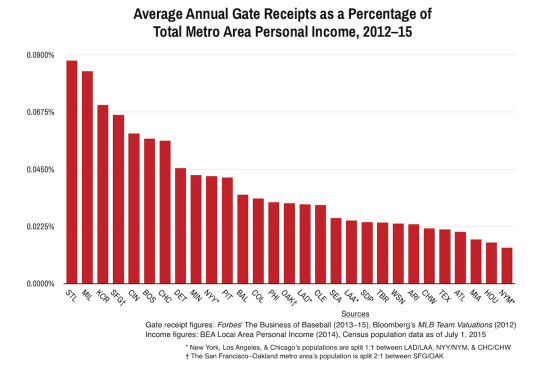
Particularly in the last few years, however, the Cardinals’ virtually unrivaled levels of fan support haven’t been matched by ownership’s investment in the on-field product. In 2015, the team’s opening-day payroll represented only 41% of the previous year’s total revenue—a ratio that ranked 23rd in the league, a few spots above the Madoff-crippled Mets and a few more above Jeffrey Loria’s notoriously parsimonious Marlins. Figures released by Forbes and other sources may not be accurate to the dollar, but the broad-strokes picture they paint is of a Cardinals organization that has gotten cheaper and cheaper over the last decade or so—from a 56% payroll-to-revenue ratio in 2008 to barely above 40% heading into the 2017 season. That’s a far steeper decline than the league-wide ratio’s two- or three-point drop over the same period.
The gap between the Cards’ top-tier fan support and low- to mid-tier spending levels has made them one of the most profitable clubs in baseball. Their 2014 operating income of $73.6 million was the league’s highest; the paltry $59.8 million they made in 2015 ranked third. In those two years alone, then, the franchise earned DeWitt and his ownership group nearly three times the amount they had paid for it twenty years earlier. A few more years at that clip, and the team that claimed it needed several hundred million dollars in public assistance to finance the construction of a new stadium will have turned a profit equal to that sum in all of a half-decade.
Cardinals ownership is swimming in cash, and the pool is only going to get deeper. Not only will a new broadcast-rights deal that begins next year raise TV revenues to an annual average of $67 million over its 15-year term—more than double the figure the team received in the last few years of its current deal—it also gives the team a 30% ownership stake in Fox Sports Midwest, income from which isn’t subject to MLB revenue-sharing system. DeWitt, who is influential among his fellow owners and close to commissioner Rob Manfred, also stands to make further truckloads of money via his share in MLB Advanced Media and its spinoff BAMTech, which landed a billion-dollar investment from Disney last year.
The Cardinals are, in short, an outrageously lucrative business venture—a fact that seems to be an open secret everywhere but in St. Louis, where great care is taken to present an image of the club as a plucky underdog that can only succeed on the field by avoiding high-dollar free agents and only remain viable off the field with ample amounts of public funding.
Bill DeWitt is not your friend. You may, having read some flattering profiles of him over the years or seen him wave smilingly in your direction at a World Series parade, feel a certain friendly affection for him, but he is not your friend. Your interests and his are rarely aligned, and they are often entirely at odds with one another.
It’s probably true that you would both like the Cardinals to win baseball games, but that’s pretty much where it ends. You’d like to buy tickets, concessions, merchandise, and TV subscriptions at the lowest possible prices and enjoy the highest-quality possible products in return; DeWitt and his ownership group would like to turn the largest possible profit by maximizing revenues and minimizing expenses, a goal that is materially, fundamentally, definitionally contradictory to your goals as a fan.
None of this is to say that Bill DeWitt is a bad person, or even that he’s a bad owner; it’s simply to accurately describe the fan-owner relationship, which is far more adversarial than it is collaborative. That’s fine—at least, fine insofar as this is the system to which we as a society have consented—as long as this reality is clearly understood.
To obfuscate that reality, though—to lionize Bill DeWitt as the Anti-Kroenke, an omnibenevolent caretaker motivated only by a desire to bestow good baseball upon St. Louis and reinvest all the money we give him in the team and community, in the face of so much evidence to the contrary—is not fine. And while it’s natural to expect that the Cardinals themselves would want to advance that narrative, when you see anyone else do it, it’s worth asking yourself whose side they’re really on.
0 notes